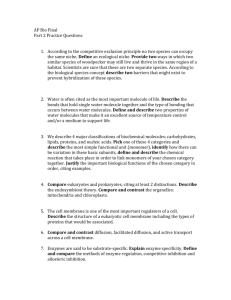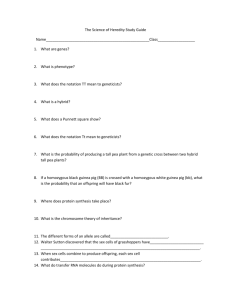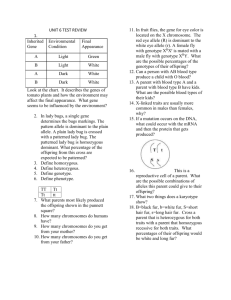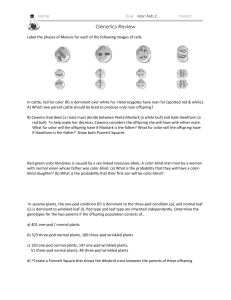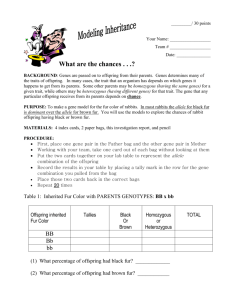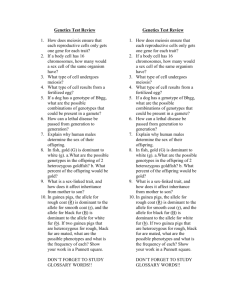IB Biology Year 1 Summer Preview 2014-2015
advertisement
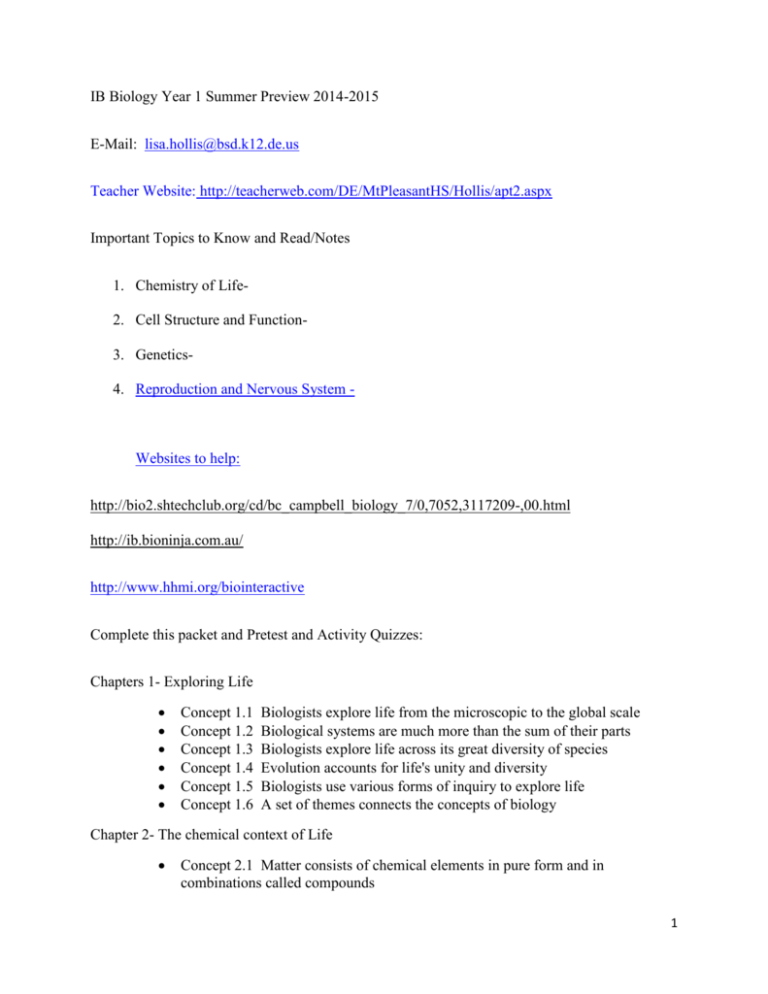
IB Biology Year 1 Summer Preview 2014-2015 E-Mail: lisa.hollis@bsd.k12.de.us Teacher Website: http://teacherweb.com/DE/MtPleasantHS/Hollis/apt2.aspx Important Topics to Know and Read/Notes 1. Chemistry of Life2. Cell Structure and Function3. Genetics4. Reproduction and Nervous System - Websites to help: http://bio2.shtechclub.org/cd/bc_campbell_biology_7/0,7052,3117209-,00.html http://ib.bioninja.com.au/ http://www.hhmi.org/biointeractive Complete this packet and Pretest and Activity Quizzes: Chapters 1- Exploring Life Concept 1.1 Concept 1.2 Concept 1.3 Concept 1.4 Concept 1.5 Concept 1.6 Biologists explore life from the microscopic to the global scale Biological systems are much more than the sum of their parts Biologists explore life across its great diversity of species Evolution accounts for life's unity and diversity Biologists use various forms of inquiry to explore life A set of themes connects the concepts of biology Chapter 2- The chemical context of Life Concept 2.1 Matter consists of chemical elements in pure form and in combinations called compounds 1 Concept 2.2 An element's properties depend on the structure of its atoms Concept 2.3 The formation and function of molecules depends on chemical bonding between atoms Concept 2.4 Chemical reactions make and break chemical bonds Chapter 3- Water and the Fitness of the Environment Concept 3.1 The polarity of water molecules results in hydrogen bonding Concept 3.2 Four emergent properties of water contribute to Earth's fitness for life Concept 3.3 Dissociation of water molecules leads to acidic and basic conditions that affect living organisms Chapter 4- Carbon and the Molecular Diversity of Life Concept 4.1 Organic chemistry is the study of carbon compounds Concept 4.2 Carbon atoms can form diverse molecules by bonding to four other atoms Concept 4.3 Functional groups are the parts of molecules involved in chemical reactions Chapter 5- The Structure and Function of Macromolecules Concept 5.1 Most macromolecules are polymers, built from monomers Concept 5.2 Carbohydrates serve as fuel and building material Concept 5.3 Lipids are a diverse group of hydrophobic molecules Concept 5.4 Proteins have many structures, resulting in a wide range of functions Concept 5.5 Nucleic acids store and transmit hereditary information Chapter 6- A Tour of the Cell Concept 6.1 To study cells, biologists use microscopes and the tools of biochemistry Concept 6.2 Eukaryotic cells have internal membranes that compartmentalize their functions Concept 6.3 The eukaryotic cell's genetic instructions are housed in the nucleus and carried out by the ribosomes Concept 6.4 The endomembrane system regulates protein traffic and performs metabolic functions in the cell Concept 6.5 Mitochondria and chloroplasts change energy from one form to another Concept 6.6 The cytoskeleton is a network of fibers that organizes structures and activities in the cell Concept 6.7 Extracellular components and connections between cells help integrate cells into higher levels of structure and function 2 Chapter 14- Mendel and the Gene Idea Concept 14.1 Mendel used the scientific approach to identify two laws of inheritance Concept 14.2 The laws of probability govern Mendelian inheritance Concept 14.3 Inheritance patterns are often more complex than predicted by simple Mendelian genetics Concept 14.4 Many human traits follow Mendelian patterns of inheritance Chapter 46- Animal Reproduction Concept 46.1 Both sexual and asexual reproduction occur in the animal kingdom Concept 46.2 Fertilization depends on mechanisms that help sperm meet eggs of the same species Concept 46.3 Reproductive organs produce and transport gametes: focus on humans Concept 46.4 In humans and other mammals, a complex interplay of hormones regulates gametogenesis Concept 46.5 In humans and other placental mammals, an embryo grows into a newborn in the mother's uterus Chapter 48- Nervous Systems Concept 48.1 Nervous systems consist of circuits of neurons and supporting cells Concept 48.2 The membrane potential is the basis of information processing by the nervous system Concept 48.3 Action potentials carry long-distance information in the nervous system Concept 48.4 Neurons communicate with other cells at synapses Concept 48.5 The vertebrate nervous system is regionally specialized Concept 48.6 The cerebral cortex controls voluntary movement and cognitive functions Concept 48.7 Much research effort is directed at treating CNS injuries and diseases There will be a quiz on them after the first full week of school. To find the website for the quizzes, type in “205.173.44.50 Campbell Biology” in Google or type in website below. http://bio2.shtechclub.org/cd/bc_campbell_biology_7/ 3 THE CHEMISTRY OF LIFE 1. Important Biomolecules Vocabulary 2. Proteins o Amino acids o Enzyme Lipids o Glycerol o Fatty acids Nucleic acids o Nucleotides Polar molecule Nonpolar molecule The four most common elements (atoms) found in living things are: 1. 3. Dehydration synthesis (condensation reaction) Covalent bonds Polymer vs. Monomer Carbohydrates o Monosaccharides: Glucose o Disaccharides Sucrose, Maltose o Polysaccharides: starch / glycogen /cellulose 2. 3. 4. Carbohydrates: 1. Are made up of monomers called ___________________. 2. _________-saccharides are two sugars linked together. 3. __________-saccharides are many sugars linked together, such as ___________________, ________________ and ___________________. 4. Provide cells with quick _____________________. 4 4. Lipids 1. Are made of 3 _________________ _____________ bonded to ____________. 2. Function in the cell to build cell _______________s and are also good for storing __________________ (calories). 5. 3. Proteins 1. Perform many functions in cells. For example, an important function of __________________ is to increase the rate of chemical reactions, by lowering the activation energy required for the reaction to take place. 2. E________________ are proteins. This figure represents an _____________ ___________. Label the functional groups that are circled. Amine ---- Acid 5 6. Nucleic Acids 1. DNA Nucleotide Complementary base pairs The two important functions of DNA in the cell are: a. It stores information that tells cells what _______________ to make. b. It contains the ______________ information that is passed from parent to offspring. 2. Label a simple DNA nucleotide showing the nitrogen base, deoxyribose sugar, and phosphate group. 3. Examine the portion of the DNA molecule that contains 12 nucleotides. Describe the shape of the molecule and the rules for complementary base pairing. 4. A DNA molecule has a sequence of T A G C T C . What is the sequence of its complementary strand? 6 7. ATP Explain the relationship between ATP and ADP. When is energy given off for cells to use? 8. _________________ bonds are very strong bonds because they share a pair of electrons between atoms. 9. A pH less than 7 indicates something is an ______________. A pH greater than 7 indicates something is a _____________. Order the following from lowest pH to highest pH: bleach, vinegar, pure water, stomach acid, blood, milk, ammonia 7 Cell Structure and Function Vocabulary Prokaryote / prokaryotic cell Eukaryote / eukaryotic cell cell membrane ribosomes cytoplasm nucleus rough endoplasmic reticulum Golgi apparatus chloroplasts mitochondria cell wall lysosomes solute solvent hypertonic hypotonic isotonic diffusion osmosis facilitated diffusion carrier proteins exocytosis equilibrium 8 1. Complete this table using terms from the vocabulary list: Cell Part 2. eukaryotic Function in the cell Regulates what enters and exits the cell Control center for eukaryotic cells; contains DNA Protein synthesis takes place on this “workbench” Converts chemical energy in food to ATP Membrane system that transports materials through the cell; if ribosomes are attached, it makes proteins Modifies and packages proteins Contain enzymes to digest damaged cell parts Converts light energy to chemical energy in plants Create a Venn diagram comparing/contrasting prokaryotic cells and cells. o Include at least 3 important facts for each category (eukaryote only; prokaryote only; all cells) o Give an example of a prokaryote and a eukaryote. 9 3. Complete the table comparing/contrasting plant and animal cells. Unique Animal Cell Structures Common Cell Structures Unique Plant Cell Structures 1. 2. 3. 4. 5. 6. 7. 4. List the 3 statements that make up the cell theory. 1. 2. 3. 10 5. Place in order from simplest to most complex level of organization: cell, atom, molecule, organ system, tissue, population, organ, organelle, organism 11 Genetics Define each term and give an example of each: Homozygous Heterozygous Dominant Recessive Genotype Phenotype Gene Allele Test cross 1. Who was Gregor Mendel, and what was his contribution to the study of genetics? 2. Make Punnett squares to predict the genotypes and phenotypes of the offspring produced by each of the following crosses. D = Dimples d = no dimples DD X DD Dd X DD DD X dd Dd X Dd dd X dd Dd X dd Does a Punnett square tell you the actual outcome of a mating? Explain. 12 3. You mate two ferrets that are heterozygous for two traits: fur color B (brown) and b (white); and fur length H (short) and h (long). These parents are brown with short-hair: BbHh x BbHh How many of the offspring would you expect to be white with long fur (recessive for both traits - bbhh)? Assume a litter of 16 kits. (Hint: Make a Punnett square for each trait, then multiply the probability of offspring with white fur by the probability of offspring with long fur to find out the probability for the two traits occurring together.) or 4. Black fur is dominant to brown fur in rabbits. You want to determine whether your black rabbit is homozygous (BB) or heterozygous (Bb). Explain why it is better to mate your rabbit with a brown rabbit than with a heterozygous black rabbit. (Note: this is called a test cross.) Have a great Summer, Lisa Hollis 13
